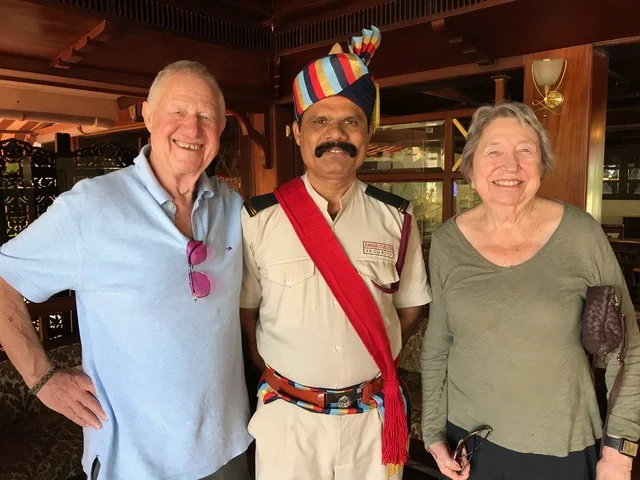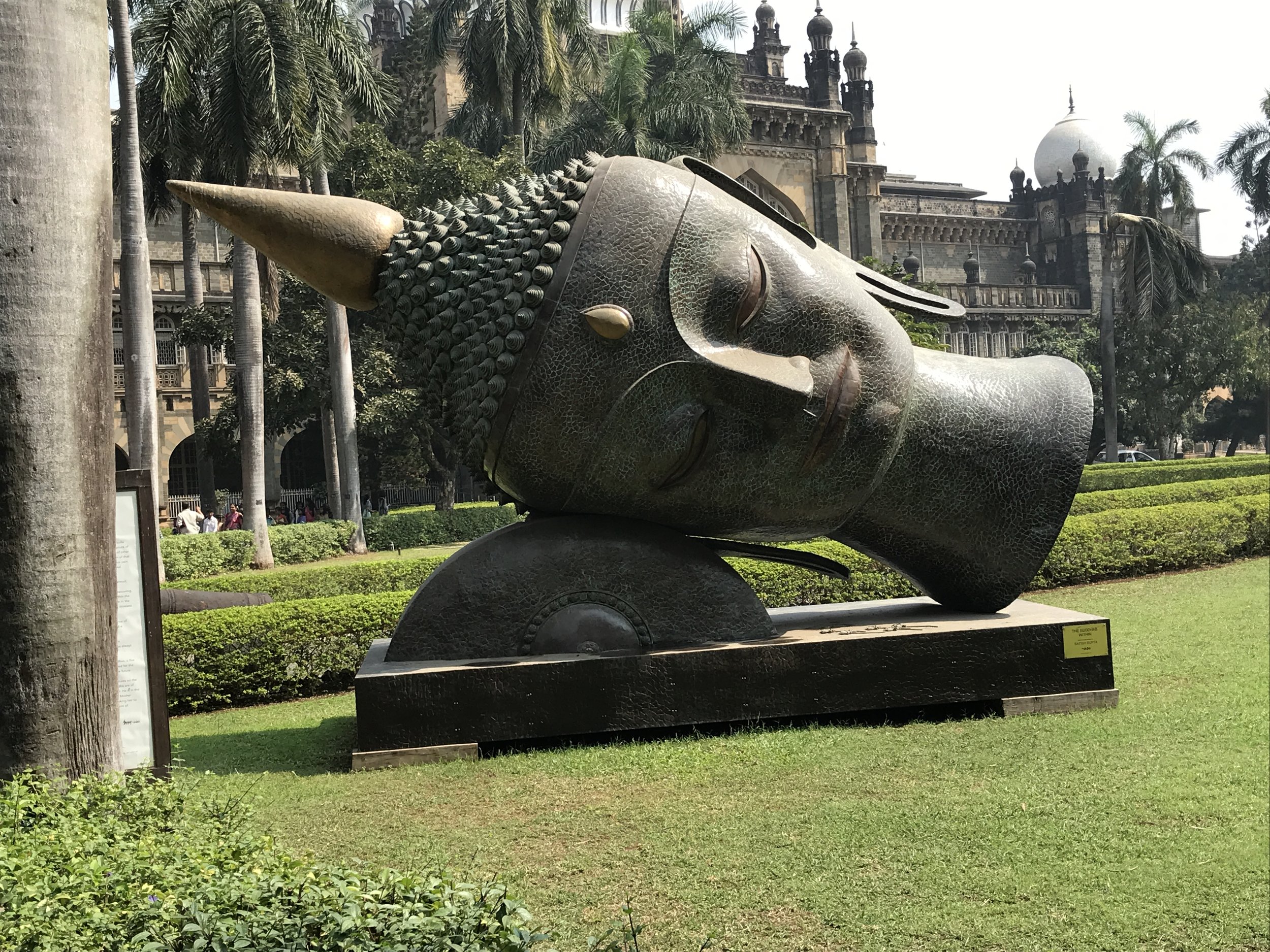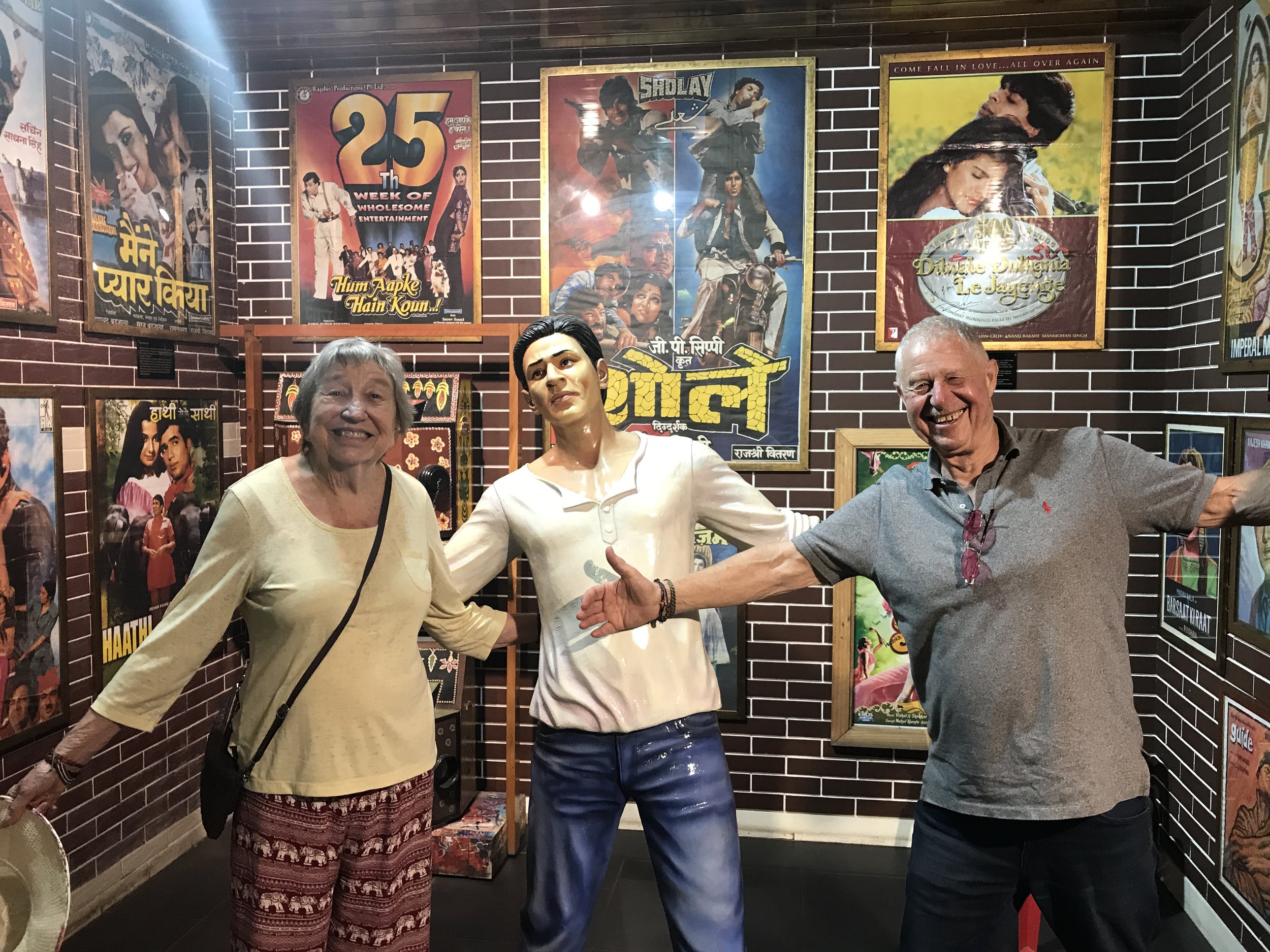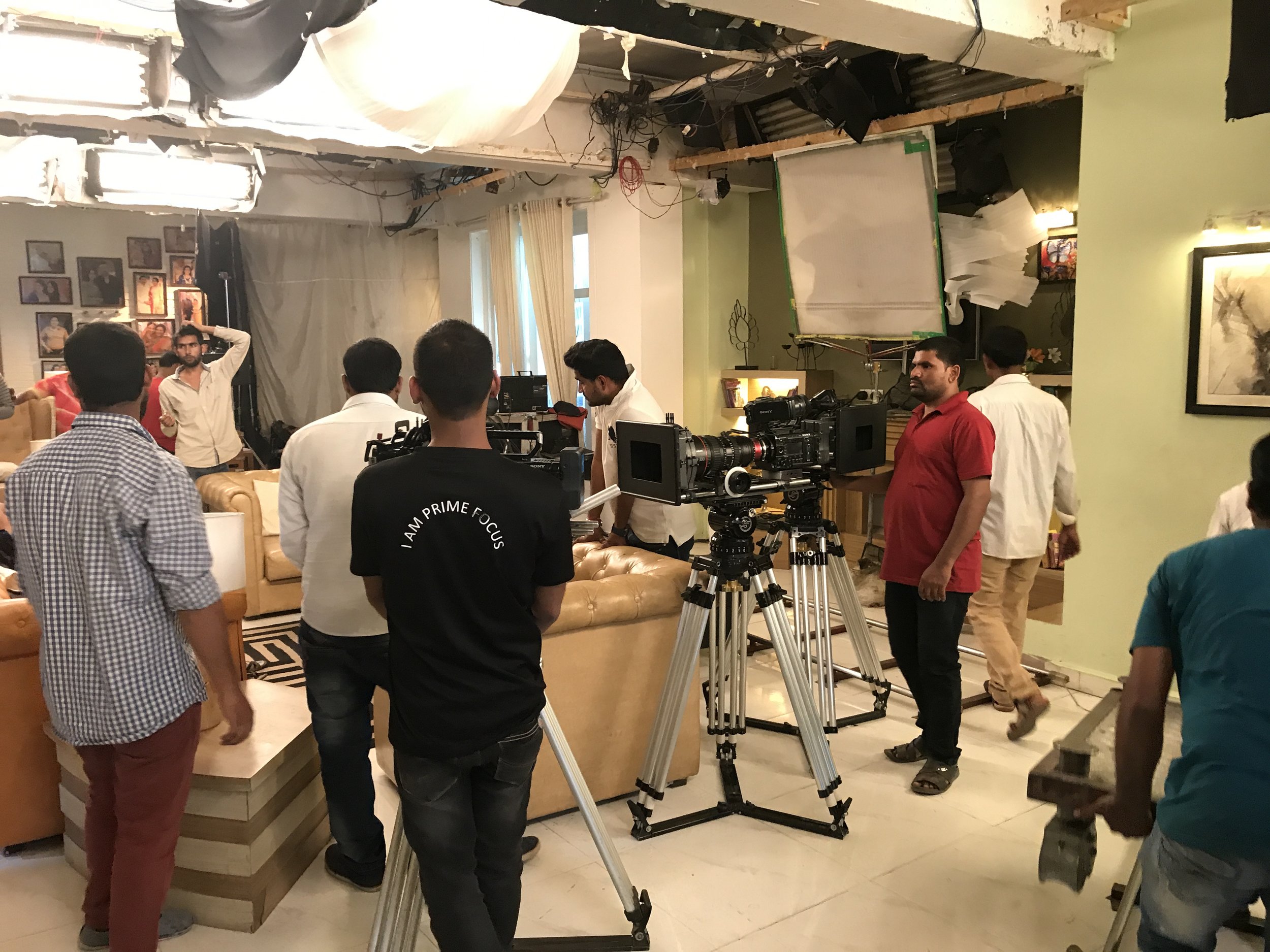India 2018
India: Exciting, amazing, colorful, full of sights, sounds, smells and experiences. It’s a continuing performance of one thousand three hundred million (1.3 billion) people engaged in the business of life, in all its forms. A non-stop frenzy of people, places and things, like nowhere else in the world.
It’s a country you either love or hate, and we love it. This was our third trip to India, and as much as we enjoyed the previous two, this was our best. India is filled with adventure, perhaps the nicest people on the planet and is much less expensive than other travel destinations, but it’s not everybody’s cup of tea. Many are put off by the poverty, chaos and ubiquitous trash, but that’s part of the Indian experience, and once you’ve made your peace with the downsides, you can enjoy India for what it is.
We arrived in Mumbai after two long flights, ten hours from SF to London, a six-hour layover in Heathrow (thankfully we had use of the British Air business class lounge), and another nine hours London to Mumbai. A long journey, but Mumbai is 8,300 miles from San Francisco, almost halfway around the world. Our two previous trips to India were to northern parts of the country, while this trip was to the south.
A one-hour taxi ride from the airport through Mumbai’s city streets, teeming with life and congested with cars and auto-rickshaws (tuk-tuks), brought us to the magnificent Taj Mahal Palace Hotel. Built in 1903 by the Indian industrialist J.N. Tata, the Taj (as it is called) is situated on the southern tip of Mumbai, across from the Gate of India, facing the Arabian Sea. It is Mumbai’s most famous landmark and the second most photographed monument in all of India. Mr. Tata built it after being refused entry into a British hotel.
From the moment we arrived at the Taj, we were treated like royalty, and spent three days in the lap of luxury while surrounded by Mumbai’s twenty million people, who mostly live in poverty. If ever you needed proof of how unfair the world is, experience the juxtaposition of this monument to wealth and success in the midst of Mumbai’s poverty.
The first morning we went to Chhatrapati Shivaji Maraharaj Vasti Museum. When we bought entry tickets, we got our first taste of tourist pricing in India. Admission for Indian seniors was ninety cents; admission for foreign seniors, that’s us, was seven and a half dollars (everything, of course, always in Indian rupees). That’s understandable, and not the first time we’ve experienced this kind of tourist pricing. An excellent museum and well worth the fifteen dollars.
Next was Chhatrapati Shivaji Terminus, formerly Victoria Terminus or VT, a huge monument to British colonial architecture combining Hindu, Islamic and Victorian styles. Even though it has UNESCO World Heritage status, its shabby condition is due to its being the busiest train station in Mumbai, a city with a population of more than 20 million.
For the fun of if, we had lunch in a McDonalds and ate a chicken burger. We knew from previous trips that cows are sacred in India, and no beef is sold. Three curious young Muslim women, sitting at the next table, who spoke reasonably good English, began a conversation, because they wanted the experience of talking with two Americans. This was to be the first of many encounters with friendly Indian people, many of who wanted to take photos of and with us.
We began our second day with breakfast at the Taj’s Sea Lounge, looking out at the Gateway to India and the Arabian Sea. We hired a taxi off the street and made a deal for spending half a day exploring Mumbai, with the driver suggesting points of interest. One highlight was the Dhobi Ghat, billed as the world’s largest laundry, where hundreds of workers wash tens of thousands of pieces of clothing, sorting by color and hanging them on lines. The massive operation is all outdoors and was a great photo op.
Another was the Dharavi slum, considered Asia’s largest shantytown, home to a million people, and the setting for the 2008 movie Slumdog Millionaire. Next was Crawford Market, where Misti bought a potpourri of Indian spices. Back at the hotel we were given a private tour of the Tata Suite, an amazing 6000 square foot suite of rooms, suitable for royalty and occupied recently by Mr. Obama.
We ended the evening with drinks at the Royal Mumbai Yacht Club, the oldest yacht club in India, housed in an elegant 1880’s building built by the Brits, which now also serves as a hotel for yachties. When I showed my Loch Lomond Yacht Club membership card, and explained that I had reciprocity with clubs all over the world, they were at first reluctant to admit us, but finally consented to honor our membership.
About money in India: The currency is the Indian rupee and the largest note is 2000 rupees. At an exchange rate of 63 rupees to the dollar, the 2000 note is about thirty dollars. Many ATM’s only give a maximum of 2500 rupees, or about $37.
We were soon to find out that using ATM’s in India could be a nightmare. With the 2016 Indian demonetization of their currency, they changed the size of the1000 rupee note, which meant that all ATM machines had to be reconfigured. This resulted in a cash crisis, since most transactions are for cash, and for months people weren’t able to use the ATM machines. It wasn’t much of a problem for us, since we booked our hotels through hotels.com, and everything in India, including meals, is very inexpensive. A small amount of cash can last for days.
Our flight to Chennai was at 3:30 pm, so after a leisurely morning, we bid adieu to the Taj Hotel and took a taxi to Mumbai airport, an hour away. The Mumbai airport is huge and impressive; nicer than many US and European airports, perhaps because it was renovated and opened in 2014. It’s ranked as the World’s Best Airport in terms of airport service quality.
An hour and a half flight on Jet Airways whisked us from Mumbai to Chennai in the southeast, where our driver, Manu, greeted and welcomed us to South India. We knew immediately we’d enjoy spending time with Manu, which was good since he’d be our driver for the next two weeks. Our car was a Toyota SUV, which we had booked online. Trip Advisor comments helped us pick a company, and the cost was reasonable, about seventy dollars a day for car, driver, tolls, parking, etc. Since we arrived early evening, we went straight to the Park Hyatt Hotel for a two-night stay.
While planning the trip, we decided that our hotel stays should be for at least two nights. One-night stays don’t allow for enough time in a city and it’s too exhausting to constantly be moving to the next place. If you check into a hotel mid or late afternoon, and then check out by noon the next day, you only have 24 hours, and that’s too rushed.
Misti found the Peshwari restaurant online and we ubered there for our first South Indian meal, which was excellent. We sat in a booth fronting the kitchen and watched the chefs work their magic in tandoori ovens. A good introduction to South Indian cuisine.
Chennai, formerly called Madras, has a population of nine million, and is the capital of Tamil Nadu state. With a population of about 75 million, Tamil Nadu is India’s sixth largest state. The largest state in India is Uttar Pradesh, with an incredibly large population of more than 200 million, larger than all but five countries in the world.
We intended Chennai only as a stopover, before heading south to more interesting pastures. We spent the day going to the fish market (dirty and smelly), seeing the beaches and old British fort and the colorful Kapaleeshwarar Temple, dedicated to the deity Shiva, one of India’s three primary deities, the others being Vishnu and Brahma.
We left Chennai headed for Mamallapuram, fifty km south. We stopped first at Cholamandal Artists’ Village, a cooperative founded in 1966 by artists of the Madras Movement, highlighting South Indian modern art. Next we went to Dakshina Chitra. a craft village with artisan workshops displaying traditional South Tamil Nadu arts and crafts.
By mid-day the heat was intense, so we decided to postpone further sightseeing and checked into the Intercontinental Hotel, abut ten miles north of Mamallapuram. Built two years ago, the hotel sprawls over seventeen acres, has an enormous pool and is quite luxurious, despite its strange architecture. We learned from previous trips to India that it’s important to find refuge each night in a luxury hotel, as a counterpoint to what many feel is the “rough edge” of traveling through India.
We got an early start the next day headed toward Mamallapuram, which has been designated as a World Heritage Site. Mahabs, as locals call it, is filled with ancient, world heritage archeological sites including temples and rock carvings, dating from the seventh century. While the archeological sites are the main tourist draw, the town itself has a good vibe. Some small hotels and restaurants and lots of touristy shops, and much cleaner than other areas we passed through.
Using Lonely Planet, we visited the three notable temples and rock carvings: Shore Temple, the Five Rathas (chariots) and Arjuna’s Pennance, giant carvings on two massive boulders. While the temple and carvings were interesting, of greater interest was our encounter with an Indian family who politely introduced themselves and began a conversation about America and what we thought about India. And, as always, lots of photos, which are especially nice because of the women’s colorful saris.
We drove a short distance south to Pondicherry, now called Pudacherry, which was under French rule until 1954. Pondy, as it is usually called, is split into the French side to the east along the Indian Ocean, and the Indian side to the west. The French Quarter is a small area containing boutique hotels and some good restaurants, while the Indian side is filled with a large population and the usual hectic activity.
We stayed at Villa Kirsh, which Misti found online, had drinks and dinner in the rooftop restaurant, and hired an auto-rickshaw (tuktuk) to show us around town and help us do some shopping, including my getting a three-dollar haircut. We love getting around in the tuk-tuks. They weave in and out of traffic, can park anywhere, the ride is exciting and the cost is minimal, a dollar or two for most trips.
About the food in India: Before this trip I wasn’t a great fan of Indian food. I felt it was too spicy and the dishes were strange looking and sounding. Several weeks of eating Indian food showed me how wrong I was. Our breakfasts were always in a hotel, western style, usually with cereal and eggs, but our other meals were Indian dishes. Indian food is mostly vegetarian, with some fish and chicken, all very tasty and healthy and amazingly inexpensive; many of our dinners were under ten dollars. Perhaps because of the heat, we were eating less and also drinking less alcohol, and when we did have an alcoholic drink, it was more often beer than wine.
A main tourist attraction in Pondicherry is a world famous ashram called Auroville, located ten kilometers north of Pondy. Our driver said it was worth seeing and we spent a couple of hours there. Auroville is a universal, experimental, utopian community, founded in 1968, as a place where people from all over the world could live in peace and harmony, with the purpose of realizing human unity. It has a population of 2,500 full-time residents, from roughly fifty different countries, mostly India, France and Germany. Frankly, I found it a bit weird, but it’s nice to know that there are people out there who are serious about trying to save humanity.
Our driver for this journey was Manu, who picked us up when we arrived at the Chennai airport, and left us two weeks later at the Lake Palace Hotel in Alappuzha, Kerala. Manu was wonderful. He had a peasant demeanor, never got angry or annoyed, even when we did stupid things, knew South India very well, and without GPS or a map, never got lost. He’d pick us up each morning, at a time we designated, always with a “good morning” and a smile, and take us to see or do whatever we had planned for the day. He’d drop us off each evening at our hotel and find his own accommodation for the night. We were on the verge of tears when the time came for us to say goodbye.
About Driving in India: It would be insane to drive in India, and it’s amazing we never saw an accident in the three weeks we were there. Maybe devotion to their gods pays off; we had hundreds of scary near misses, which we suppose is just part of the game. In the cities traffic barely moves, and the constant jockeying for position creates chaos. Watching cars, trucks and motorcycles coming straight at you and then veering at the last second, like a game of chicken, is a bit unnerving, but it’s the way it works, and it’s not for the faint of heart.
Cows in India: It’s weird seeing cows wandering around streets and sidewalks, usually unfettered. In India, cows are considered sacred, their slaughter is prohibited and beef isn’t served in restaurants. Manu told us that cows are not “wild”, and each belongs to a family or group of families. After wandering the streets by day, at night they return home.
Next on our itinerary was Madurai, 200 miles from Pondicherrry, a five-hour drive through not very especially scenic countryside. Madurai, referred to as “Temple City”, is a city of one and a half million and its claim to fame is the Meenakshi Amman Temple, one of the oldest and most important in India, dating back to the third century BC. The temple is spread over 14 acres in the center of Madurai and has four multi-story towers connected by a series of gateways. All the structures are covered with tens of thousands of mythological figures, giving it a striking appearance. It was nominated as one of the wonders of the world, but couldn’t make the list of “Seven Wonders of the World”.
We arrived mid-day and found thousands of Hindus praying, chanting and offering flowers to an assortment of deities. We chose not to have a guide but rather just wandered through the temple and grounds, observing all the activity and the colorful women’s clothing. We were a bit of a curiosity and were asked by many people to take their photo.
From Madurai we drove on to the Periyar Tiger Reserve, a national park in India’s mountainous Western Ghats, in Kerala state. Despite its name, not many tigers to be seen, but lots of monkeys, buffalo and all sorts of tropical flora. We were now in a hill station at a higher altitude, considerably cooler and more comfortable than Tamil Nadu state. Manu arranged for a private tour of a spice plantation as well as a boat ride on the Periyar River.
After two nights at the Poetree Sarovar hotel, near the Tiger Reserve, we went on to the Kerala backwaters, the highlight of South India. The Kerala Backwaters are a network of interconnected canals, rivers, lakes and inlets, a system formed by more than 500 miles of waterways, and sometimes compared to the American Bayou. In the midst of this landscape there are a number of towns and cities, which serve as the starting and end points of backwater cruises.
Visitors typically spend several nights cruising the canals, some living on elaborate houseboats. There are thousands, complete with bedrooms, dining room and a staff. Cost is low, perhaps one hundred dollars a night, depending on the size of the boat. We opted to cruise for only several hours, on a small private boat, which was enough to give us a good feel for the backwaters and see and photograph river life.
After two nights at the Lake Palace hotel in Alappuzha, we headed south down the mountain toward Kochi. The two-hour ride down the mountain was lovely, with waterfalls and tea and coffee plantations on both sides of the road.
Kochi, also called Cochin, was our final destination in South India. It’s a major southwest Indian city, which has been a port since 1341, when a flood created a harbor and opened it to Arab, Chinese and European merchants. Because we had booked a flight from Kochi to Colombo, Sri Lanka, we were only able to spend one night in Kochi, which wasn’t enough time. The next day we taxi’d to the Kochi airport for a one-hour flight to Colombo, and the adventure of a new country, Sri Lanka.
After ten days in Sri Lanka, we began our long voyage home. Because we wanted to break up the long trip, from Sri Lanka to San Francisco, through Mumbai and London, we decided to spend one night in Mumbai to rest. That gave us another full day in Mumbai, which we used to tour a Bollywood movie studio, SJ Studios, interesting and very different than what you find in Hollywood. We toured the movie sets and watched as they were filming an Indian soap opera.
Bollywood produces more than twice as many films each year as Hollywood. The name Bollywood comes from “Bombay”, which was previously Mumbai’s name. American film and video companies have been watching Bollywood’s success, and we learned that two major companies, Amazon and Netflix, are exploring partnering with Bollywood studios.
We left Mumbai at 2:15 am on a British Air flight, headed first for London and then onto San Francisco, about 30 hours of traveling and a guarantee of nasty jet lag when we got home. Thus ended our India adventure, filled with many wonderful and memorable experiences.
Art Faibisch
March 12, 2018

































































































































